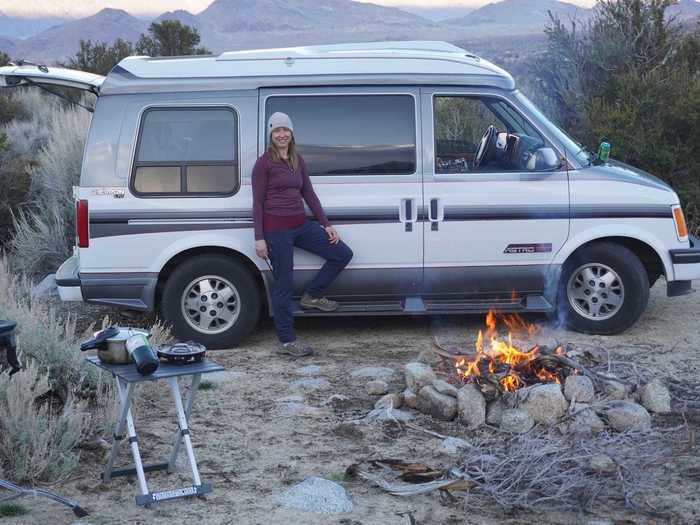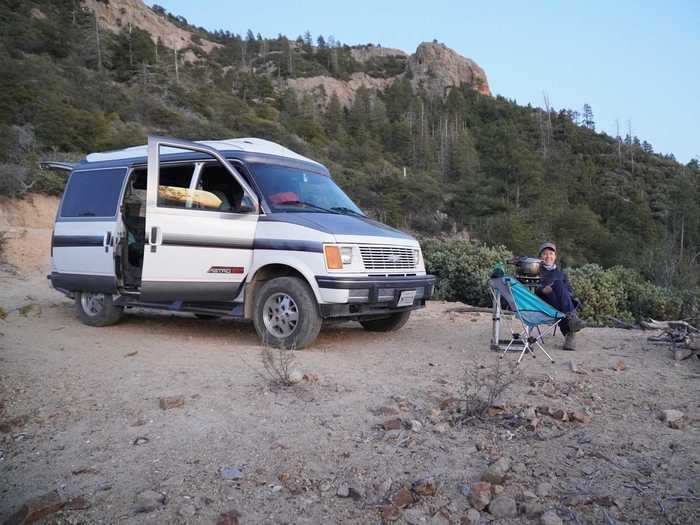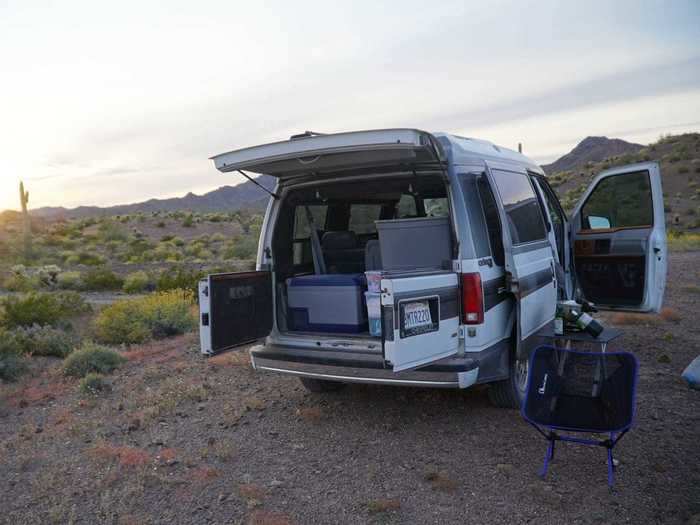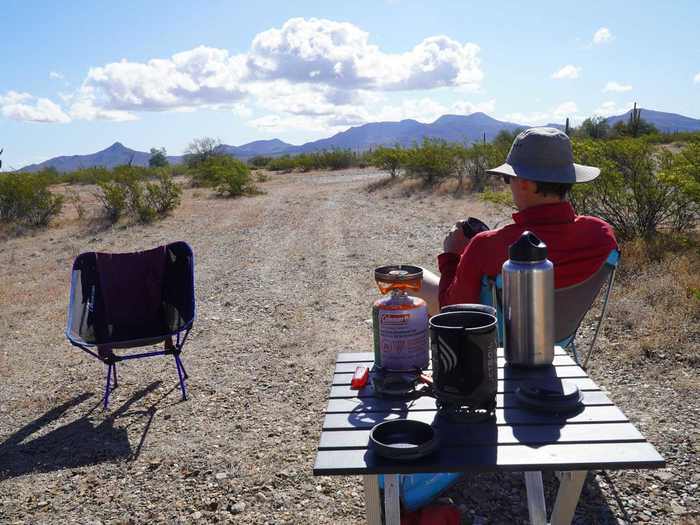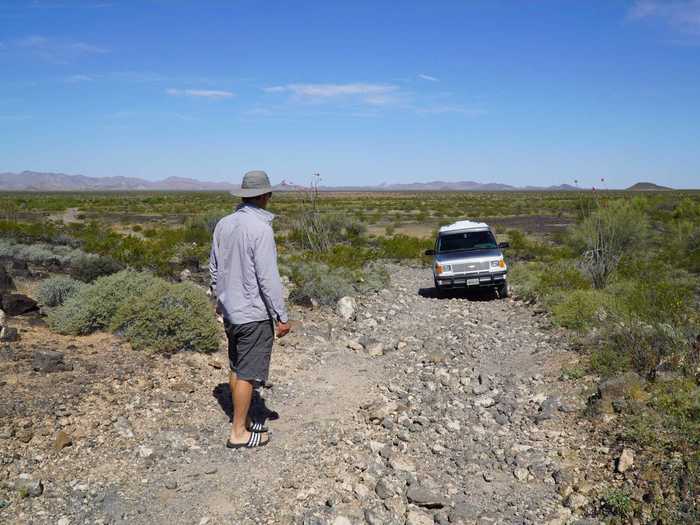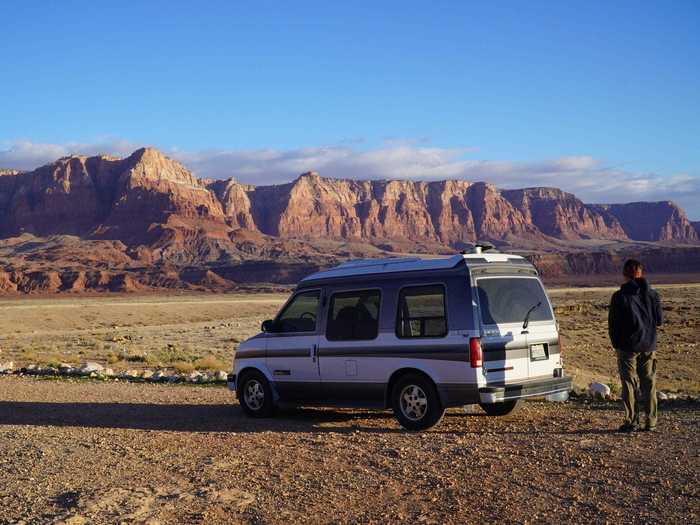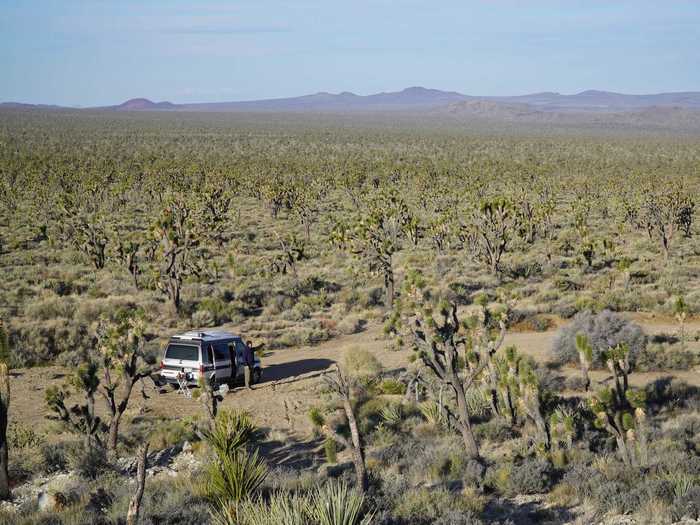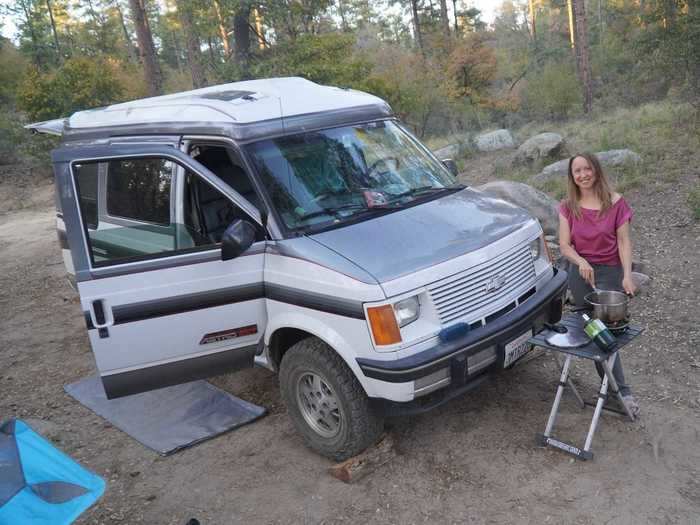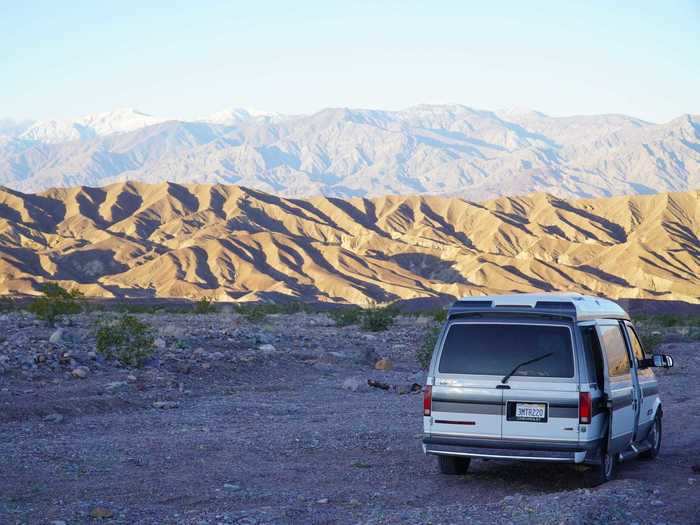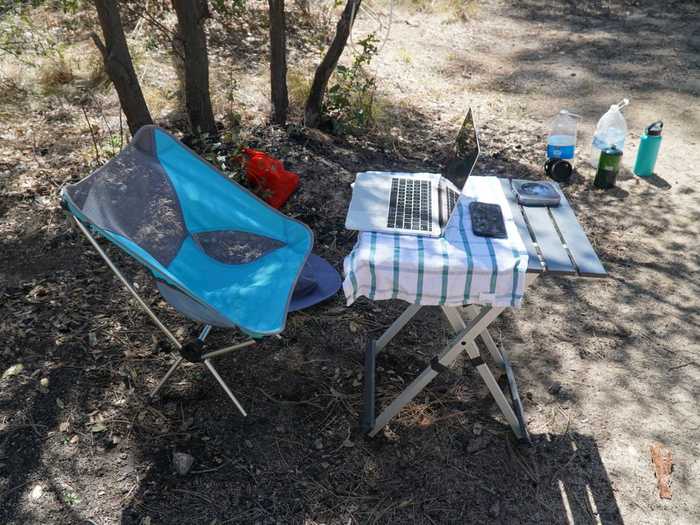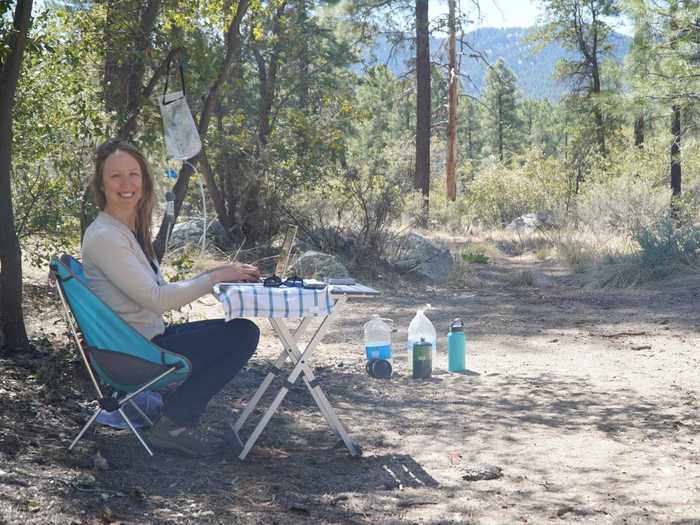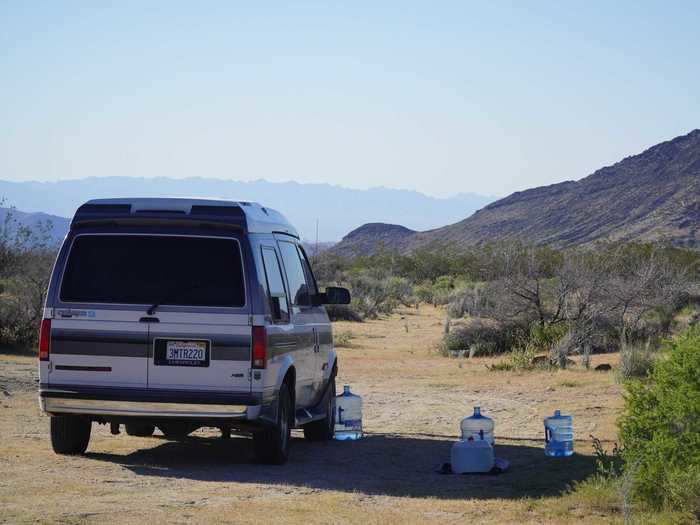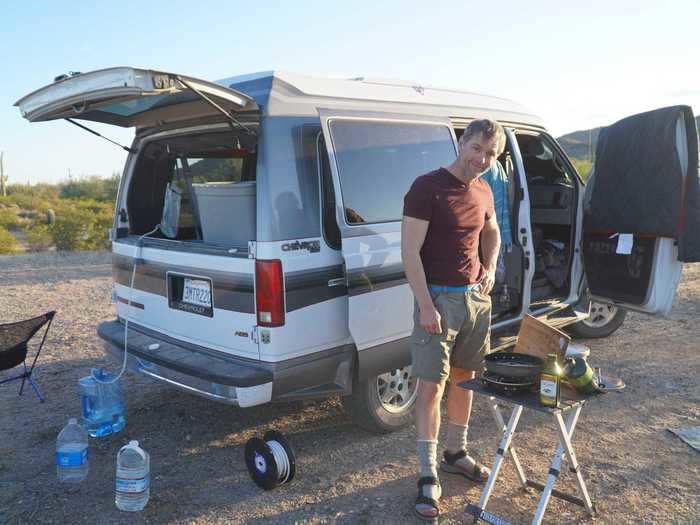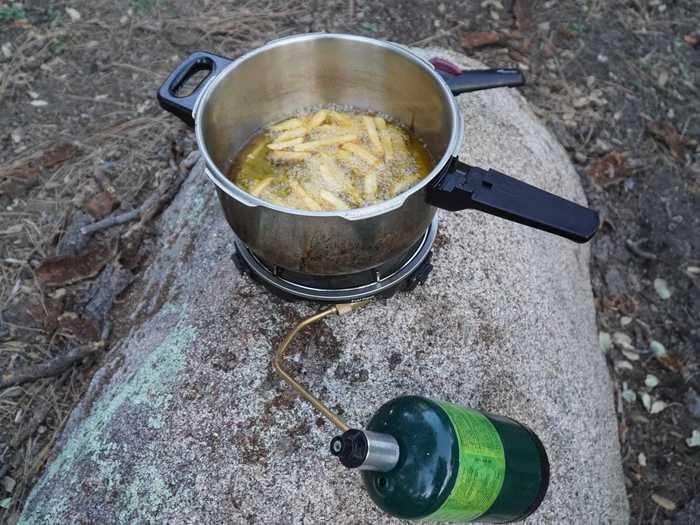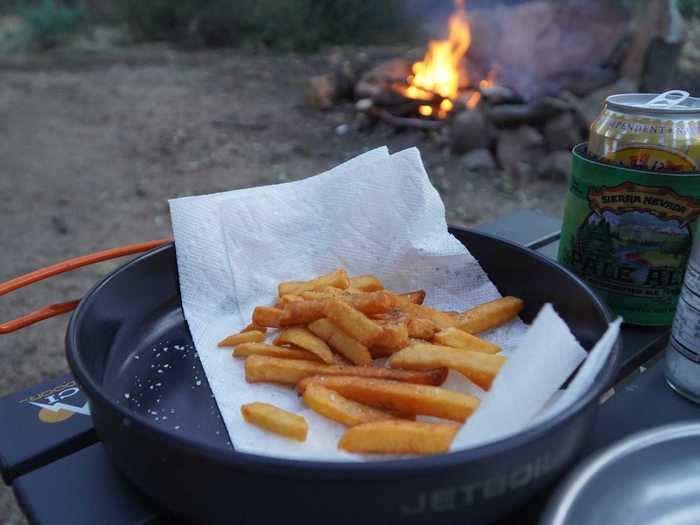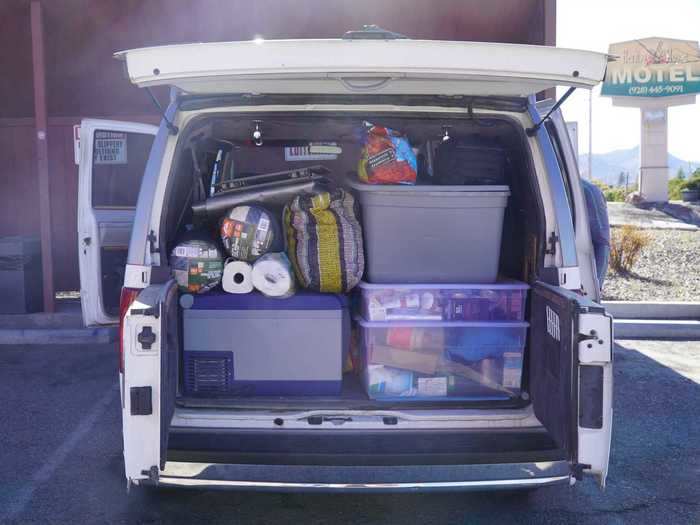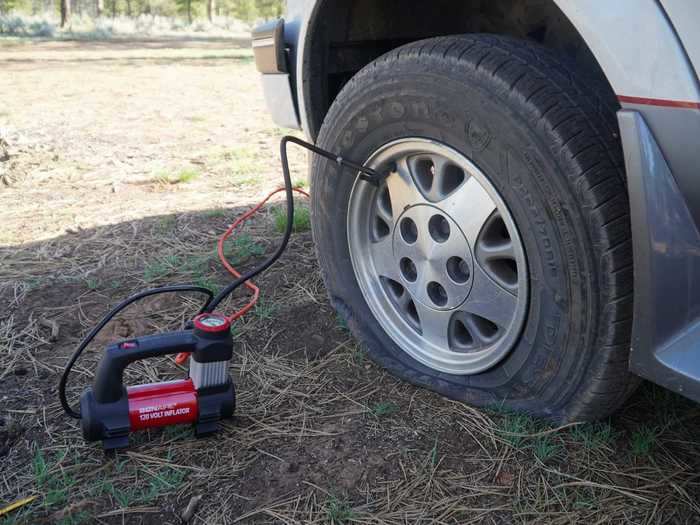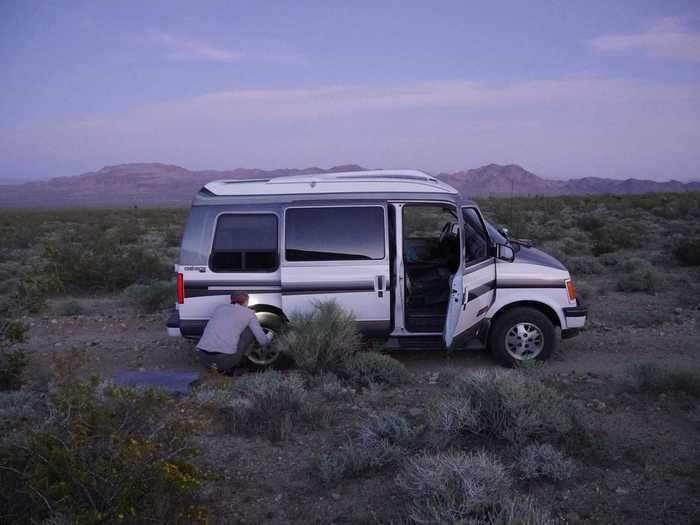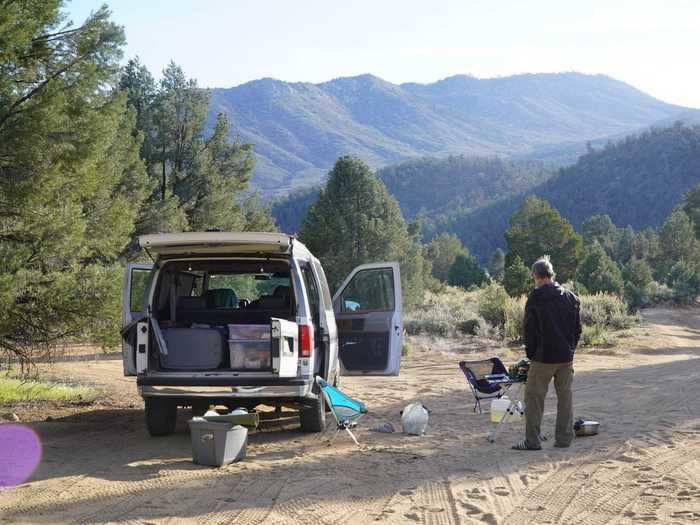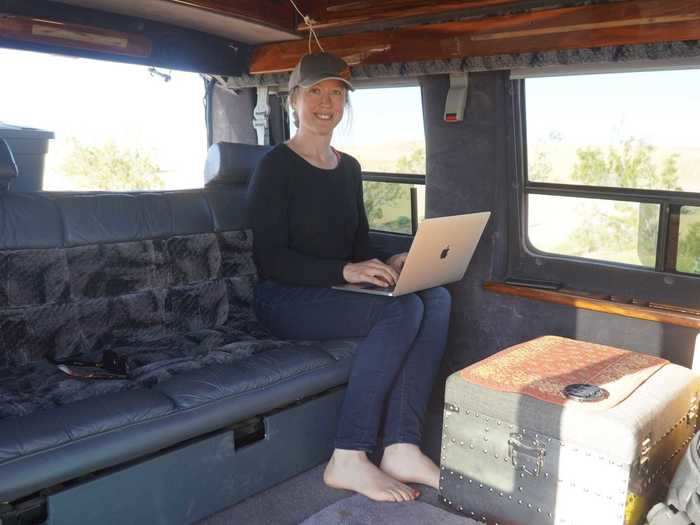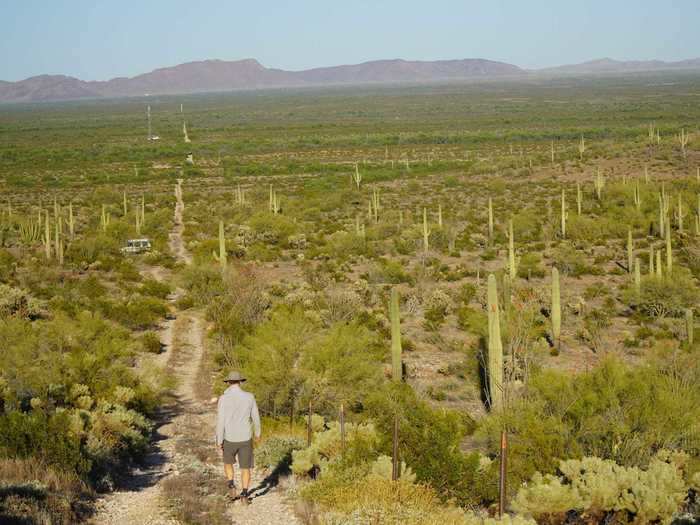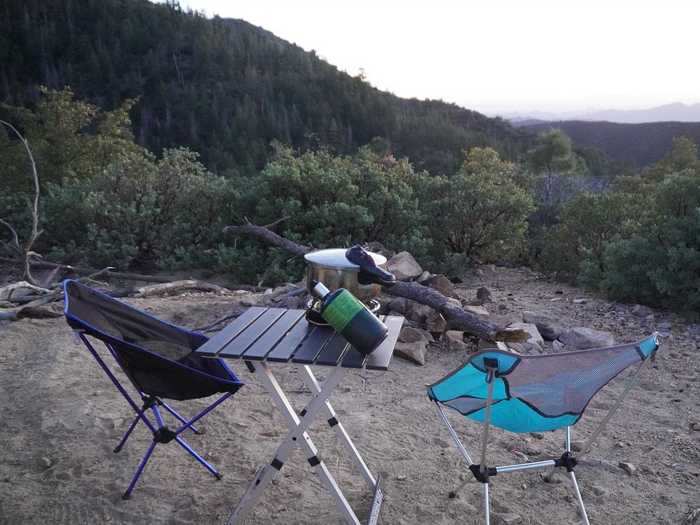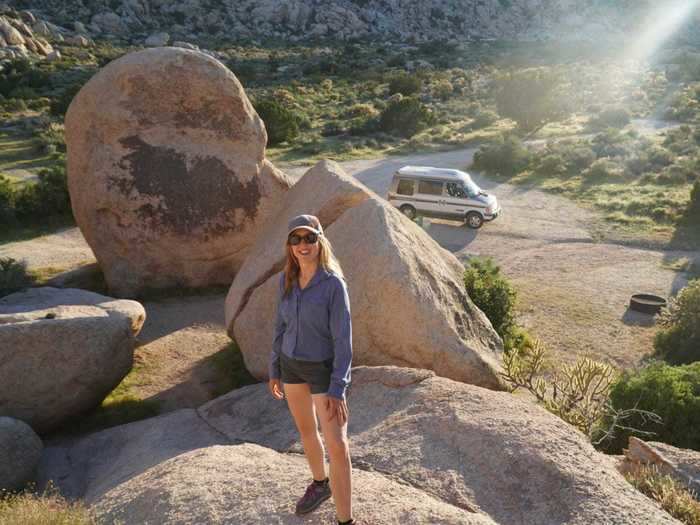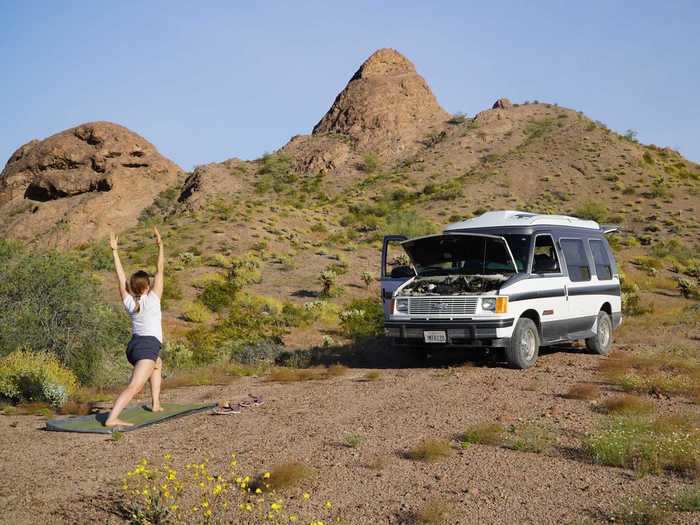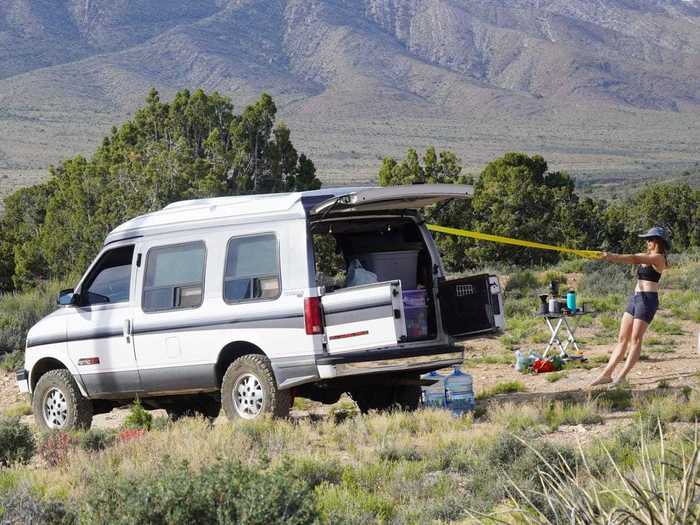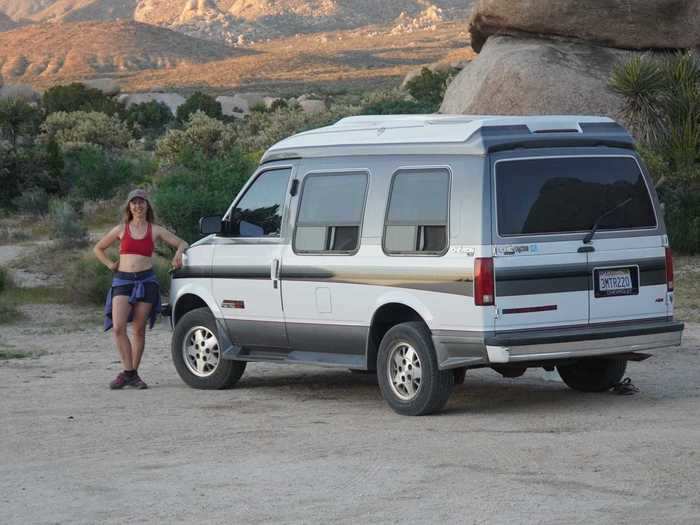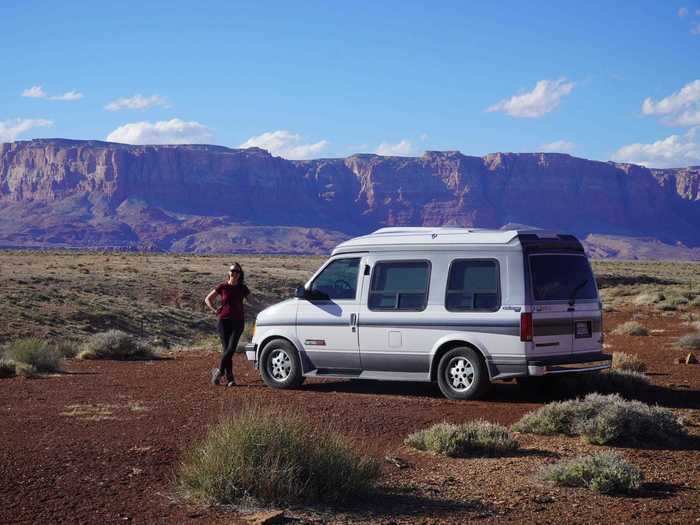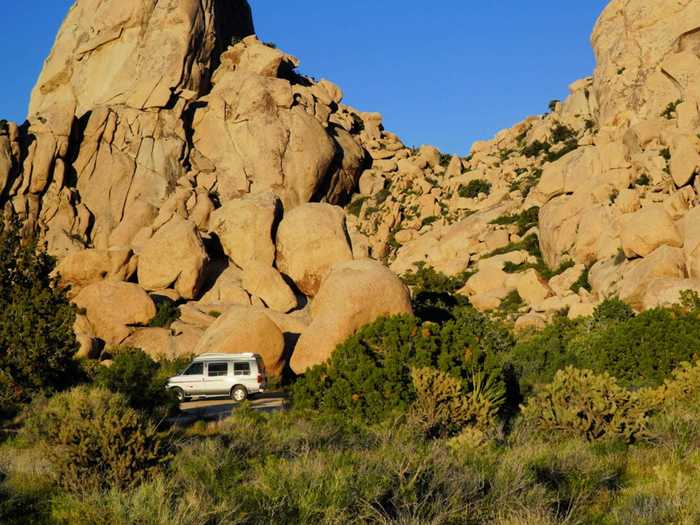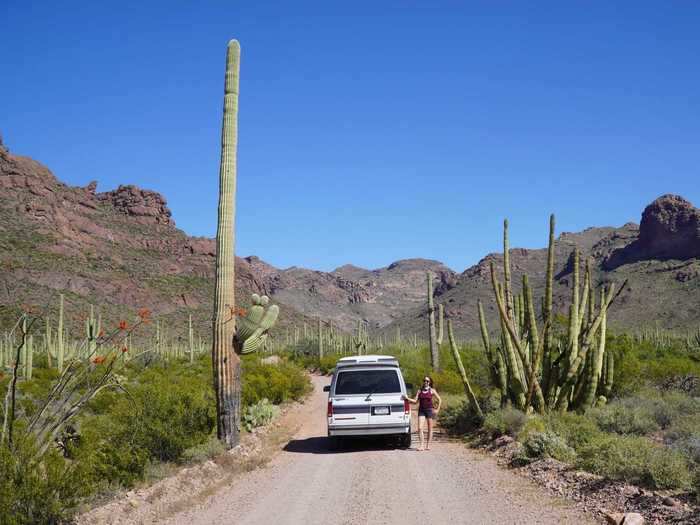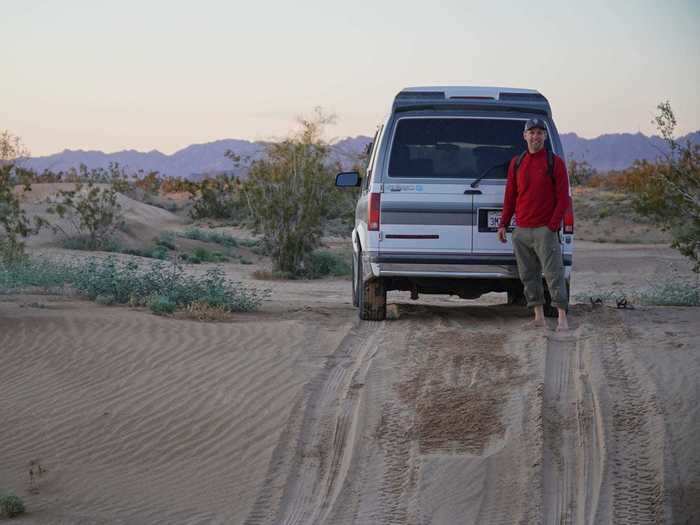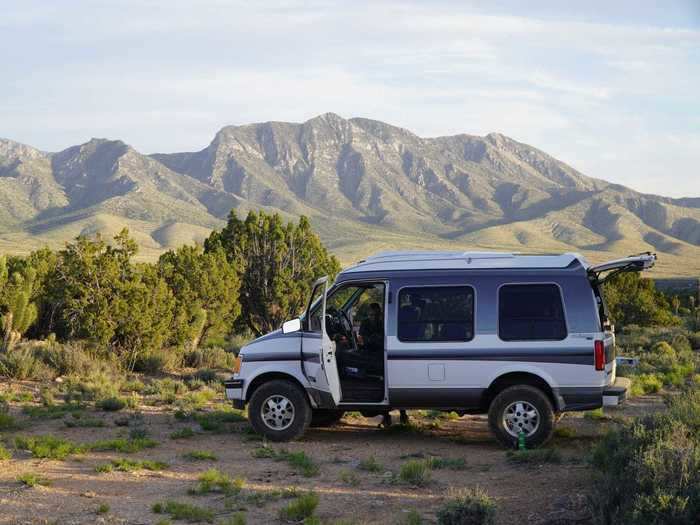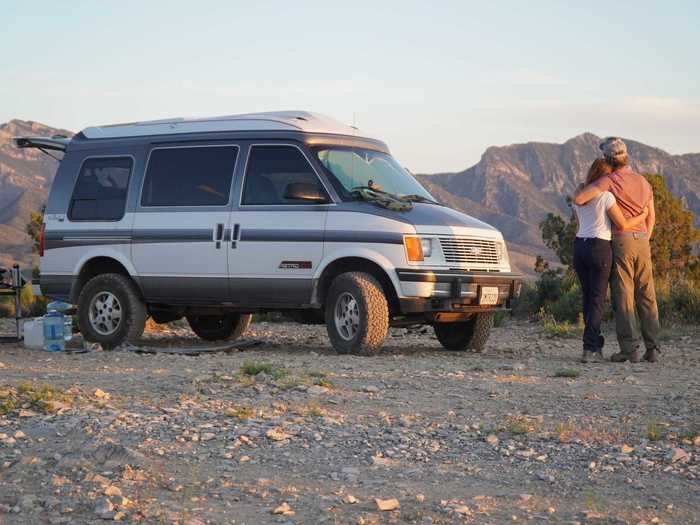Lovell Canyon Road west of Las Vegas.Kristin Hanes
- A California couple has been living in their van and traveling through the desert for about two months during the coronavirus pandemic and statewide stay-at-home order.
- Kristin Hanes and her partner bought the van as their home two years ago and usually live out of it in the San Francisco Bay Area.
- Now, they hop from campsite to campsite, working remotely with a hotspot and sleeping in their camper van for around $1,000 a month.
- Life on the road has involved flat tires, swarms of bugs, fluctuating temperatures, and weekly 7 am Walmart trips to stock up on food.
- Hanes told Business Insider that she's content with the setup and thinks there may be more interest in the van lifestyle in the future as many may rethink their housing situations in light of the pandemic-driven economic fallout.
Thousands of California residents have been isolated in their homes since Gov. Gavin Newsom issued a stay-at-home order on March 19.
Many are likely going stir-crazy while cooped up, with many having to do so in pint-sized apartments.
But one California couple is taking the tiny home lifestyle to the next level. Kristin Hanes and her partner usually live out of their 1994 Chevy Astro campervan in the San Francisco Bay Area. Now, they're traveling through the desert as the world weathers the storm caused by the coronavirus disease, known as COVID-19.
"Even though it's a teeny, tiny space, I feel like when we're out camping, we actually have a huge backyard," Kristin Hanes told Business Insider.
Here's how they're doing it.
Read the original article on
Business Insider
Kristin Hanes and her partner, Tom, are a California couple currently living and traveling in their 1994 Chevy Astro van through the statewide stay-at-home order.
The Alabama Hills National Recreation Area.
Kristin Hanes
The couple is usually based in San Francisco Bay Area, parking their van in various campgrounds in the region.
Hanes was laid off from her job as a radio news reporter in 2016, and with the sudden crushing loss of income, gave up her $1,500-a-month apartment and moved onto her partner's sailboat.
They've been embracing the tiny living lifestyle ever since as a way to make ends meet.
El Camino Del Diablo in Arizona.
Kristin Hanes
They split their time between the sailboat docked in Ventura, just outside of Los Angeles, and the van that Hanes bought two years ago for $6,000.
Senator Highway in the Prescott National Forest in Arizona.
Kristin Hanes
However, they don't have live-aboard status at their Ventura marina, meaning they can't legally live on their sailboat for more than a few days. They've only been back to the boat docked in Ventura twice since all of this began.
So they've been living in the van for about two months, the longest period of time they've done so consecutively.
El Camino Del Diablo in Arizona.
Kristin Hanes
They started traveling even before the statewide stay-at-home order went into effect on March 19. They wanted to steer clear of populated areas after learning of how the virus was already spreading.
Sonoran Desert National Monument in Arizona.
Kristin Hanes
They stay far away from others on the infrequent occasion that they encounter anyone — Hanes said they've barely come across anybody while camping.
Hanes said it was a bit intimidating. She was thinking about if they could even cross state lines, or how they would explain their living situation to law enforcement if they ever got pulled over.
El Camino del Diablo in Arizona.
Kristin Hanes
"It is kind of scary when you're living in a van to have a shelter-in-place order," Hanes told Business Insider.
But they've found a good rhythm so far.
A lot of campsites and RV parks closed when the statewide stay-at-home order was issued, Hanes said.
Vermilion Cliffs National Monument in Arizona.
Kristin Hanes
Hanes said that was a big problem for acquaintances of theirs who rely upon reservations at those campgrounds and were kicked out with nowhere else to go.
So Hanes said she and her partner started going into national parks and Bureau of Land Management (BLM) lands where you can camp for free.
They've been to the Mojave Desert in California, which is still open for dispersed camping.
Mojave Desert National Preserve.
Kristin Hanes
They've been to the Prescott National Forest near Flagstaff, Arizona.
Prescott National Forest in Arizona.
Kristin Hanes
They've camped at Sonoran Desert National Park just south of Phoenix.
Sonoran Desert National Monument in Arizona.
Kristin Hanes
And they've visited California's Death Valley National Park.
Death Valley National Park in California.
Kristin Hanes
Where they go and where they camp largely depends on the weather and the strength of the internet connection.
Dispersed camping in the Prescott National Forest in Arizona.
Kristin Hanes
Finding campsites with strong connections in places where the weather is suitable can take hours, she said.
Hanes is a full-time blogger for her site Wayward Home.
Dispersed camping in the Prescott National Forest in Arizona.
Kristin Hanes
She documents her van lifestyle among other things on the site, which is her primary source of income. Her partner usually works as an electrical contractor in San Francisco, but his work is paused in light of the pandemic. He's studying to become a licensed ham radio operator for the time being.
So they may be traveling, but finding a sturdy connection during the day is crucial. The couple has a hotspot supplying unlimited internet connection, and Hanes said they try to find campsites with phone signals.
"It's been pretty amazing," she said. "We've deep in the desert or in the forest and I'm able to work. So that's been pretty phenomenal to just sit in nature and be able to have access to the internet out there."
One of the first lessons they learned in the past few weeks was to carry more water containers. They used to be able to fill them at campsites, but since the order called for them to close, that's not an option.
Mojave Desert National Preserve.
Kristin Hanes
So they bought large jugs from Walmart for 30 cents a gallon, as well as a filtration system.
Sonoran Desert National Monument in Arizona. The filter is the small bag hanging in the back of the van.
Kristin Hanes
They can collect fresh, cold water from mountain streams and then put it through the system.
They go to Walmart once a week, typically at 7 am to avoid crowds, and they always wear masks, she said.
Prescott National Forest in Arizona.
Kristin Hanes
Each trip gives them seven to 10 days of food, and they make sure to eat the vegetables first.
Prescott National Forest in Arizona.
Kristin Hanes
There's a 37-quart fridge in the van powered by a solar panel that keeps their food supply fresh.
Prescott, Arizona.
Kristin Hanes
The van came with a fold-down back seat that makes a bed. Hanes and her partner each have a bin to store their clothes. In addition to the solar panels, there are two batteries mounted under the van.
They also quickly learned to retrofit the van into even more of an efficient off-roader.
Kaibab National Forest in Arizona.
Kristin Hanes
The van wasn't used to such prolonged time spent in rough terrain.
Early on, the street tires on the van proved less than rugged, and one went out on them. They had to plug it in the middle of the desert before having more durable truck tires installed.
Adapting the van gave Hanes peace of mind.
"If these weird pandemic things happen, we have a way to get out, drive down a rough dirt road, and actually camp for like a week," she said.
Mojave Desert National Preserve.
Kristin Hanes
Hanes said the most expensive part of van life is the cost for gas, but that depends on how far you drive.
Mojave Desert National Preserve.
Kristin Hanes
If they're staying in the desert for a few days, the cost is lower. But if they drive a further distance to Prescott, Arizona, the gas bill could easily reach $600 for the month.
Typically, costs sit at about $1,000 for them a month, including gas and food.
Kennedy Meadows in California.
Kristin Hanes
As for how the couple is faring while living in such small spaces, Hanes said they do well together. After Hanes was laid off in 2016, she and her partner even successfully lived out of a Prius for a time.
Imperial Sand Dunes in California.
Kristin Hanes
And the two have much more outdoor space than other sheltered-in-place residents in the Bay Area.
"I think that really helps with the sheltering in place aspect — just being outside and having access to nature and hiking," Hanes said. "I think it's really good for us — our souls."
Bureau of Land Management (BLM) land north of Organ Pipe Cactus National Monument in Arizona.
Kristin Hanes
Sometimes she'll work outside, while her partner works inside the van. Then she'll walk to a different area of the campsite to do some yoga.
And then in the evenings, the two will come back together to cook dinner.
Senator Highway in Prescott National Forest in Arizona.
Kristin Hanes
Hanes tries to stay active. Traveling in a van actually involves a lot of sitting, a reality that many office workers in their homes are also now familiar with now that they're not putting in their regular commute.
Mojave Desert National Preserve.
Kristin Hanes
The pair go on hikes through the terrain wherever they're parked, or she'll do yoga sessions with the desert sky as her backdrop.
Southern Arizona, close to El Camino del Diablo on the Barry M. Goldwater Range.
Kristin Hanes
She's also attached a resistance band to the van to use as her "homemade TRX system."
Lovell Canyon Road west of Las Vegas.
Kristin Hanes
The weather can fluctuate depending on where they are. In the Mojave Desert, it can be in the 90s, so the two will wear shorts and tank tops.
Mojave Desert National Preserve.
Kristin Hanes
But in the mountains, it can get down into the 30s, so they'll double up on pants and use their sleeping bags that are designed to withstand the cold.
Calling desert environments their temporary homes has made for some insect and wildlife encounters.
Vermilion Cliffs National Monument in Arizona.
Kristin Hanes
While parked in the Mojave Desert, hordes of gnats descended upon Hanes and her partner around dinnertime, landing on them and their food.
Mojave Desert National Preserve.
Kristin Hanes
On another occasion, clusters of mice scurried in the area surrounding the van.
At another campsite near Las Vegas, about 30 honey bees made themselves at home in the couple's water reserve.
And at a campsite in Flagstaff, huge black moths swarmed them one day.
But she said she's happy with her lifestyle right now, despite the uncertainty that many are feeling during the pandemic.
Organ Pipe Cactus National Monument in Arizona.
Kristin Hanes
"Between that and being on the boat and being able to go out to the Channel Islands where there's nobody or being able to just be out sailing is comforting — to know that we have those places where we can escape weird things like pandemics or natural disasters," she said. "We have our little escape pod."
And she thinks many more people might be interested in the van lifestyle after the pandemic.
Imperial Sand Dunes in California.
Kristin Hanes
The costs are much lower than conventional homeowning. As the pandemic continues to threaten to send the economy into a downward spiral, living in tinier spaces may be a reality for many.
Lovell Canyon Road west of Las Vegas.
Kristin Hanes
It'll likely only be one long-term effect of the pandemic.
"I've noticed that after being in nature for so long, I come back to a city and it just really freaks me out seeing so many people and so much concrete, and I just want to run away from it," Hanes said.
Lovell Canyon Road west of Las Vegas.
Kristin Hanes
"It's weird that this disease around has us has totally reformulated how we think about being near others, which is sad."

